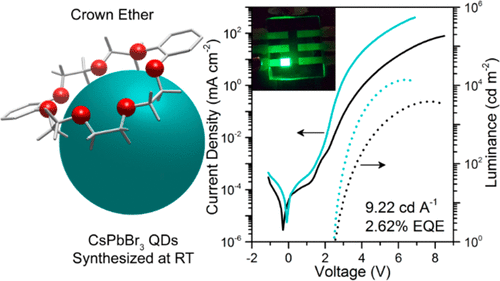当前位置:
X-MOL 学术
›
ACS Energy Lett.
›
论文详情
Our official English website, www.x-mol.net, welcomes your feedback! (Note: you will need to create a separate account there.)
Crown Ethers Enable Room-Temperature Synthesis of CsPbBr3 Quantum Dots for Light-Emitting Diodes
ACS Energy Letters ( IF 22.0 ) Pub Date : 2018-02-01 00:00:00 , DOI: 10.1021/acsenergylett.7b01257 Sjoerd A. Veldhuis 1 , Yan Fong Ng 1, 2, 3 , Riyas Ahmad 1, 2 , Annalisa Bruno 1 , Nur Fadilah Jamaludin 1, 2, 3 , Bahulayan Damodaran 1 , Nripan Mathews 1, 3 , Subodh G. Mhaisalkar 1, 3
ACS Energy Letters ( IF 22.0 ) Pub Date : 2018-02-01 00:00:00 , DOI: 10.1021/acsenergylett.7b01257 Sjoerd A. Veldhuis 1 , Yan Fong Ng 1, 2, 3 , Riyas Ahmad 1, 2 , Annalisa Bruno 1 , Nur Fadilah Jamaludin 1, 2, 3 , Bahulayan Damodaran 1 , Nripan Mathews 1, 3 , Subodh G. Mhaisalkar 1, 3
Affiliation

|
The synthesis of all-inorganic cesium lead halide perovskite quantum dots (QDs) typically requires high temperatures, stringent conditions, large quantities of surface ligands, and judicious purification steps to overcome ligand-induced charge injection barriers in optoelectronic devices. Low-temperature syntheses generally require lower ligand concentrations but are severely limited by the low solubility of the Cs precursor. We describe an innovative and general approach employing crown ethers under ambient conditions to overcome these solubility limitations. The crown ethers facilitate complete dissolution of the CsBr precursor, rendering CsPbBr3 QD inks practical for device fabrication. The resultant light-emitting diodes (LEDs) displayed bright green emission, with a current efficiency and external quantum efficiency of 9.22 cd A–1 and 2.64%, respectively. This represents the first LED based on CsPbBr3 QDs prepared at room temperature. Lastly, the crown ethers form core–shell structures, opening new avenues to exploit their strong coordination strength.
中文翻译:

冠醚可实现室温合成CsPbBr 3量子点的发光二极管。
全无机卤化铯铅钙钛矿量子点(QDs)的合成通常需要高温,严格条件,大量表面配体和明智的纯化步骤,以克服光电器件中配体引起的电荷注入障碍。低温合成通常需要较低的配体浓度,但由于Cs前体的低溶解度而受到严重限制。我们描述了一种创新的通用方法,该方法在环境条件下使用冠醚来克服这些溶解度限制。冠醚有助于CsBr前体的完全溶解,从而使CsPbBr 3QD油墨可用于设备制造。所得的发光二极管(LED)显示出明亮的绿色发射,电流效率和外部量子效率分别为9.22 cd A -1和2.64%。这代表了第一个基于CsPbBr 3 QD在室温下制备的LED 。最后,冠醚形成核-壳结构,从而开辟了新的途径来利用其强大的配位强度。
更新日期:2018-02-01
中文翻译:

冠醚可实现室温合成CsPbBr 3量子点的发光二极管。
全无机卤化铯铅钙钛矿量子点(QDs)的合成通常需要高温,严格条件,大量表面配体和明智的纯化步骤,以克服光电器件中配体引起的电荷注入障碍。低温合成通常需要较低的配体浓度,但由于Cs前体的低溶解度而受到严重限制。我们描述了一种创新的通用方法,该方法在环境条件下使用冠醚来克服这些溶解度限制。冠醚有助于CsBr前体的完全溶解,从而使CsPbBr 3QD油墨可用于设备制造。所得的发光二极管(LED)显示出明亮的绿色发射,电流效率和外部量子效率分别为9.22 cd A -1和2.64%。这代表了第一个基于CsPbBr 3 QD在室温下制备的LED 。最后,冠醚形成核-壳结构,从而开辟了新的途径来利用其强大的配位强度。



























 京公网安备 11010802027423号
京公网安备 11010802027423号